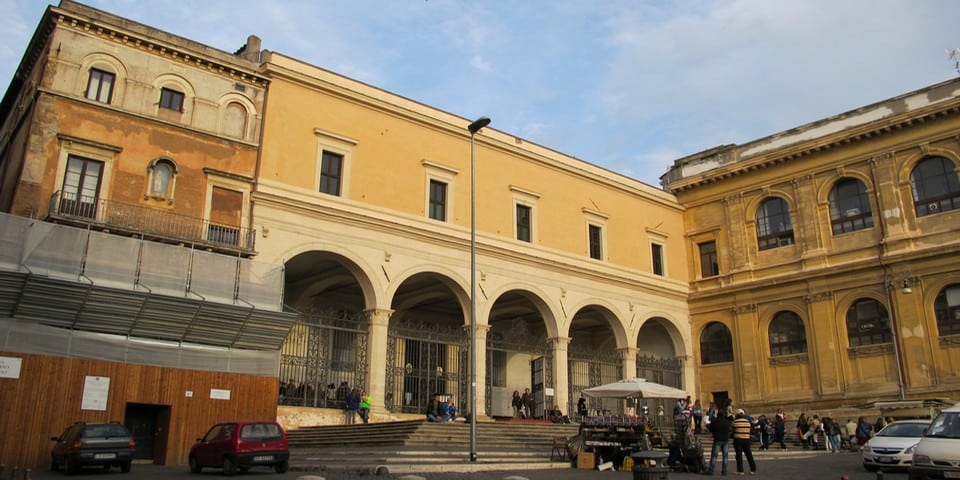

24858 views

| Tip | The church is located on Oppian Hill near Cavour metro station, a short distance from the Colosseum. |
|---|---|
| Opening Hours |
Sunday:
- ,
-
Monday:
- ,
-
Tuesday:
- ,
-
Wednesday:
- ,
-
Thursday:
- ,
-
Friday:
- ,
-
Saturday:
- ,
-
|
| Recommended tour | |
| Closest bus stops |
|
| Closest subway stations |
|
| Address | Piazza di San Pietro in Vincoli, 4/a, Roma |
Mass timeMass is celebrated:
|
|
San Pietro in Vincoli (Saint Peter in Chains) is a Roman Catholic titular church and minor basilica. It is famous for housing Michelangelo’s statue of Moses, which is part of Pope Julius II’s tomb.
The Titulus S. Pietri ad vincula was given on 20 November 2010, to Donald Wuerl. The previous Cardinal Priest of the basilica was Pio Laghi, who died on 11 January 2009.
Contents
ToggleInitially, the church was named the Basilica Eudoxiana. However, it was first rebuilt on older foundations in 432-440 to house the relic of chains that bound Saint Peter when he was imprisoned in Jerusalem, the episode called “Liberation of Saint Peter.” The Empress Eudoxia, the wife of Emperor Valentinian III, received them as a gift from her mother, Aelia Eudocia. In contrast, Aelia had received these chains as a gift from the juvenile bishop of Jerusalem.
Discover more about San Pietro in Vincoli during a private guided tour over Christian Rome, “the City of Popes.”
In the 15th century, Juvenal, the bishop of Jerusalem, presented the chains that possibly held St. Peter while he was imprisoned in Jerusalem to Eudoxia’s mother. Eudoxia then gave the chains as a present to Pope Leo I, who decided to place them in this church, together with the chains that held St. Peter while he was in the Mamertine prison in Rome.
According to legend, when Leo compared the two chains, they miraculously fused together. The chains are now kept in a reliquary under the main altar in the basilica
The interior has a nave and two aisles, with three apses divided by antique Doric columns. The aisles are surmounted by cross-vaults and the 18th-century ceiling, frescoed in the center by Giovanni Battista Parodi, portraying the Miracle of the Chains (1706).
Other artworks inside the basilica include two canvases of Saint Augustine and St. Margaret by Guercino, the monument of Cardinal Girolamo Aguchi designed by Domenichino, who is also the painter of a sacristy fresco representing the Liberation of St. Peter (1604.) The altarpiece on the first chapel to the left is a Deposition by Cristoforo Roncalli. The tomb of Cardinal Nicholas of Kues (1464), Cardinal Nicholas before St Peter, is by Andrea Bregno.
Moreover, painter and sculptor Antonio Pollaiuolo is buried at the left side of the entrance. The tomb of Cardinal Cinzio Passeri Aldobrandini, decorated with an allegorical skeletal representation of Death, is also located in the church.
The monumental Tomb of Pope Julius II was never intended to be inside the basilica but in the new St Peter’s Basilica. The present wall monument was a massively downgraded version of an original freestanding tomb project, when mooted in 1505, it would have had about 40 statues by Michelangelo.
There are 2 sculptures of Slaves at the Louvre in Paris, 4 unfinished Slaves at the Accademia Gallery in Florence and an unfinished Victory at the Palazzo Vecchio also in Florence
On the pope’s tomb, there are 7 full-figure statues and 4 bearded hero-caryatids.
The basilica is mainly famous because of the tomb of Giuliano della Rovere, who in 1503 became Pope Julius II. In 1505, he asked Michelangelo to come to Rome to work on his tomb. Michelangelo designed a huge monument and went to Florence to select the best blocks of Carrara marble to start sculpting. However, in 1508, the pope decided he wanted Michelangelo to begin working on the Sistine Chapel. Shortly after the ceiling of the Sistine Chapel was finished, Julius II died, and his successors commissioned Michelangelo with other tasks. By the time Michelangelo died in 1564, only the statues of Moses, Leah, Rachel, and two dying slaves were completed.
Nowadays, no one knows exactly what the monument was initially supposed to look like. First, there is the statue of Moses that prominently takes a central position. He is flanked by Leah and Rachel, both created in the latter years of Michelangelo’s life. Michelangelo’s students designed the statues above Moses.
Even Michelangelo considered the statue one of his best works, and the story says that he found it so lifelike that he started talking to Moses. When the statue didn’t answer, Michelangelo became angry and he threw a chisel at the knee of Moses. Nowadays, you can see the cut on the statue’s right knee
Interesting fact: the horns on Moses’s head result from an incorrect translation of the Old Testament. In the Middle Ages, it was thought that the original scripture said that Moses’s head was horned. However, in reality, the text says that his face ‘radiated.’
Author: Kate Zusmann
This website uses cookies. For more info read the cookies policy
Rome.us © 2025. Created with love by Roman experts and guides.